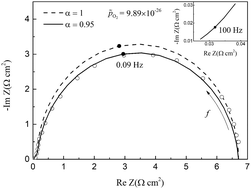当前位置:
X-MOL 学术
›
Phys. Chem. Chem. Phys.
›
论文详情
Our official English website, www.x-mol.net, welcomes your feedback! (Note: you will need to create a separate account there.)
Modeling the impedance spectra of mixed conducting thin films with exposed and embedded current collectors
Physical Chemistry Chemical Physics ( IF 3.3 ) Pub Date : 2017-09-18 00:00:00 , DOI: 10.1039/c7cp03703a Jiapeng Liu 1, 2, 3 , Francesco Ciucci 1, 2, 2, 3, 4
Physical Chemistry Chemical Physics ( IF 3.3 ) Pub Date : 2017-09-18 00:00:00 , DOI: 10.1039/c7cp03703a Jiapeng Liu 1, 2, 3 , Francesco Ciucci 1, 2, 2, 3, 4
Affiliation

|
In this article, we develop a new finite-element-based model for the simulation of the electrochemical impedance spectroscopy (EIS) response of mixed ionic electronic conducting (MIEC) thin films. We first validated the model against experimental data for Sm-doped CeO2 (SDC) symmetrical films deposited on an yittria-stabilized ZrO2 (YSZ) substrate, a pure ionic conductor. We first studied the configuration where the patterned electrodes are placed on top of the MIEC (“exposed” configuration). Our model is capable of correctly reproducing the EIS response and the total capacitance, together with their dependence on the oxygen partial pressure. Furthermore, we were able to show, in agreement with experiments, that the area specific resistance (Rp) is relatively insensitive to the density of triple phase boundaries. As a second step, we studied the configuration where the metal current collector is directly deposited on the ionic conductor and is, therefore, “embedded” into the MIEC. We were again able to reproduce the experimental EIS response. We also discovered that at sufficiently high frequencies, the EIS deviates from a traditional RC-type response, leading to features attributable to the coupling ionic and electronic transport. This coupling ultimately adds to the area specific resistance. The latter, however, can be minimized if the film is sufficiently thick or if the current collector configuration is chosen judiciously.
中文翻译:

用暴露和嵌入的集电器对混合导电薄膜的阻抗谱建模
在本文中,我们开发了一种基于有限元的新模型,用于模拟混合离子电子导电(MIEC)薄膜的电化学阻抗谱(EIS)响应。我们首先针对沉积在氧化钇稳定的ZrO 2(YSZ)衬底(纯离子导体)上的Sm掺杂CeO 2(SDC)对称膜的实验数据验证了该模型。我们首先研究了将图案化电极放置在MIEC上方的配置(“暴露”配置)。我们的模型能够正确地再现EIS响应和总电容,以及它们对氧气分压的依赖性。此外,与实验一致,我们能够证明面积比电阻(R p)对三相边界的密度相对不敏感。第二步,我们研究了金属集电器直接沉积在离子导体上并因此“嵌入”到MIEC中的配置。我们再次能够重现实验性EIS响应。我们还发现,在足够高的频率下,EIS偏离了传统的RC型响应,从而导致了离子和电子传输耦合的特征。该耦合最终增加了面积比电阻。然而,如果膜足够厚或明智地选择集电器配置,则后者可以最小化。
更新日期:2017-09-22
中文翻译:

用暴露和嵌入的集电器对混合导电薄膜的阻抗谱建模
在本文中,我们开发了一种基于有限元的新模型,用于模拟混合离子电子导电(MIEC)薄膜的电化学阻抗谱(EIS)响应。我们首先针对沉积在氧化钇稳定的ZrO 2(YSZ)衬底(纯离子导体)上的Sm掺杂CeO 2(SDC)对称膜的实验数据验证了该模型。我们首先研究了将图案化电极放置在MIEC上方的配置(“暴露”配置)。我们的模型能够正确地再现EIS响应和总电容,以及它们对氧气分压的依赖性。此外,与实验一致,我们能够证明面积比电阻(R p)对三相边界的密度相对不敏感。第二步,我们研究了金属集电器直接沉积在离子导体上并因此“嵌入”到MIEC中的配置。我们再次能够重现实验性EIS响应。我们还发现,在足够高的频率下,EIS偏离了传统的RC型响应,从而导致了离子和电子传输耦合的特征。该耦合最终增加了面积比电阻。然而,如果膜足够厚或明智地选择集电器配置,则后者可以最小化。


























 京公网安备 11010802027423号
京公网安备 11010802027423号